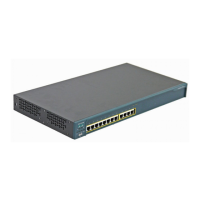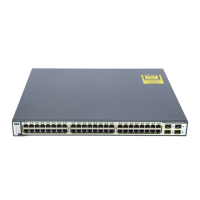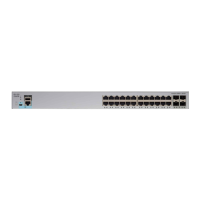13-2
Catalyst 6500 Series Switch Software Configuration Guide—Release 8.7
OL-8978-04
Chapter 13 Configuring CEF for PFC2 and PFC3A
Understanding How Layer 3 Switching Works
Understanding How Layer 3 Switching Works
These sections describe Layer 3 switching with PFC2:
• Layer 3 Switching Overview, page 13-2
• Understanding Layer 3-Switched Packet Rewrite, page 13-2
• Understanding CEF for PFC2/PFC3A, page 13-5
• Understanding the NetFlow Statistics, page 13-11
Layer 3 Switching Overview
Note With Supervisor Engine 720 (MSFC3), IPX routing is done through the software.
Layer 3 switching allows a switch, instead of a router, to forward the IP and IPX unicast traffic and the
IP multicast traffic between the VLANs. Layer 3 switching is implemented in the hardware and provides
wire-speed interVLAN forwarding on the switch, rather than on MSFC2/MSFC3. Layer 3 switching
requires minimal support from MSFC2/MSFC3. MSFC2/MSFC3 routes any traffic that cannot be
Layer 3 switched.
Note Layer 3 switching supports the routing protocols that are configured on MSFC2/MSFC3. Layer 3
switching does not replace the routing protocols that are configured on MSFC2/MSFC3. Layer 3
switching uses Protocol Independent Multicast (PIM) for multicast route determination.
Layer 3 switching on Catalyst 6500 series switches provides flow statistics that you can use to identify
the traffic characteristics for administration, planning, and troubleshooting. Layer 3 switching uses
NetFlow Data Export (NDE) to export the flow statistics. See Chapter 16, “Configuring NDE”
for more
information about NDE.
Note Traffic is Layer 3 switched after being processed by the VLAN access control list (VACL) feature and
the quality of service (QoS) feature.
Understanding Layer 3-Switched Packet Rewrite
Note With Supervisor Engine 720 (MSFC3), IPX routing is done through the software.
When a packet is Layer 3 switched from a source in one VLAN to a destination in another VLAN, the
switch performs a packet rewrite at the egress port that is based on information learned from
MSFC2/MSFC3 so that the packets appear to have been routed by MSFC2/MSFC3.
Note Rather than just forwarding IP multicast packets, the PFC2/PFC3A replicates them as necessary on the
appropriate VLANs.
